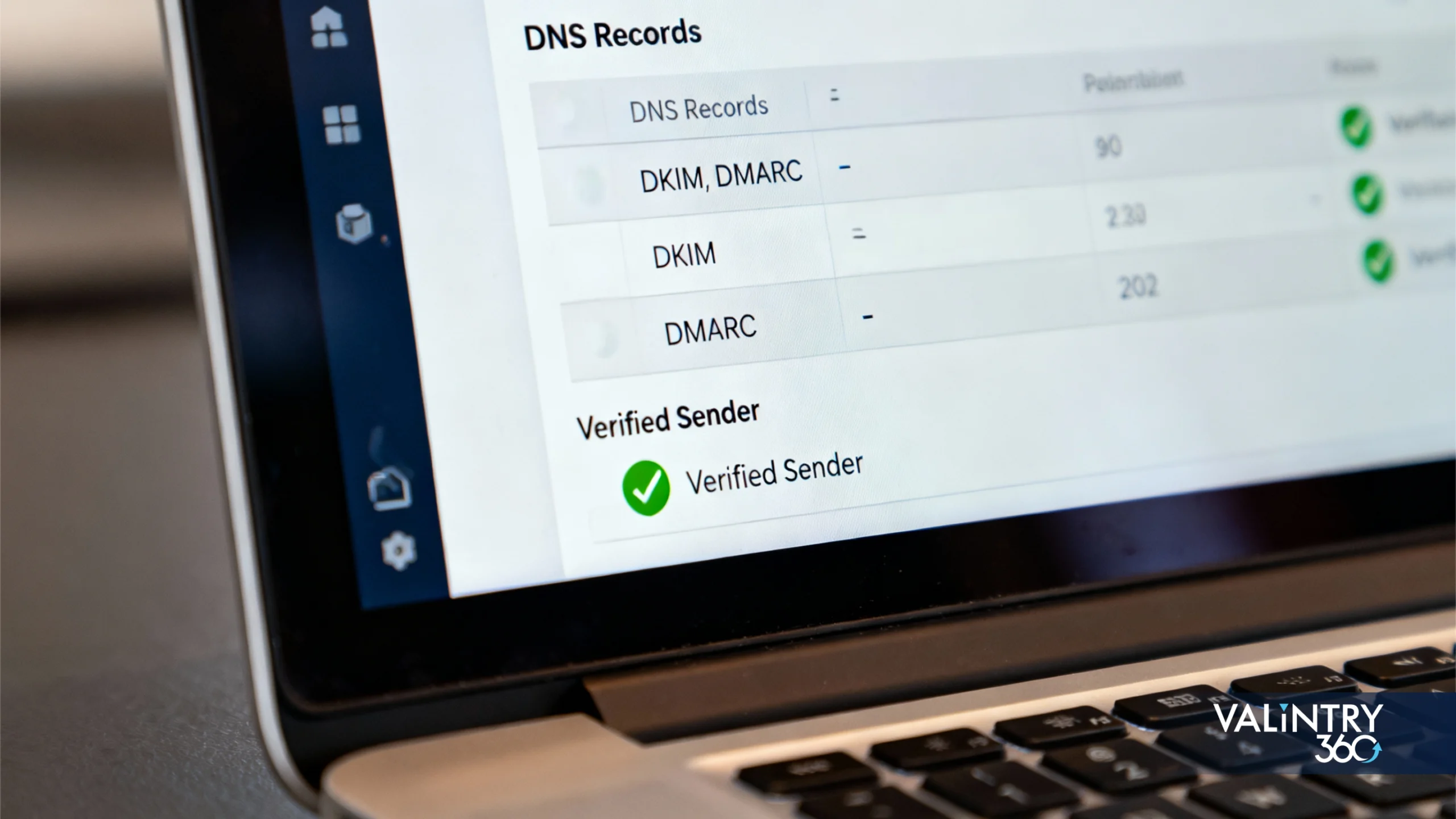
Around 16% of emails never reach their intended inbox, often ending up in spam. This is a challenge for Marketing Cloud Account Engagement users striving for effective email marketing ROI. Recent studies show that only about 80% of emails successfully reach inboxes, with approximately 7% classified as spam, resulting in missed opportunities for businesses. Since the COVID pandemic, the volume of emails has doubled, making competition for inbox placement even tougher. At VALiNTRY360, we recognize that proper email authentication is vital for improving deliverability. Sender reputation, assessed by services like Sender Score, is key; a higher score means more trust from receiving servers.
This guide will cover the setup of SPF, DKIM, and DMARC in Marketing Cloud Account Engagement, along with tips on testing authentication settings, maintaining list hygiene, and best practices to ensure messages reach their audience.
Overview
Understanding Email Authentication in Marketing Cloud Account Engagement
Email authentication serves as the foundation of successful email marketing campaigns in Marketing Cloud Account Engagement. Before diving into implementation details, let’s understand what these protocols are and why they matter for your business.
What is SPF, DKIM, and DMARC?
SPF (Sender Policy Framework) functions like an employee directory for your domain, specifying which servers are authorized to send emails on your behalf. This TXT record in your DNS lists all permitted IP addresses that can send messages from your domain.
DKIM (DomainKeys Identified Mail) works as a digital signature that validates email authenticity. Similar to a signature on a check, DKIM uses cryptography to verify message origin and content integrity. The system employs a private key (kept secret) to sign emails and a public key (stored in DNS) that receiving servers use for verification.
DMARC (Domain-based Message Authentication, Reporting, and Conformance) builds upon SPF and DKIM by instructing receiving mail servers how to handle messages that fail authentication. Moreover, it provides valuable reporting on authentication results, helping you identify and resolve delivery issues.
Why authentication matters for inbox placement
Proper email authentication directly influences whether your carefully crafted Marketing Cloud Account Engagement campaigns reach their intended destination. Without authentication, emails may be throttled, sent to spam folders, or completely blocked.
Think of authentication as your passport when traveling internationally—without proper documentation, you’ll be denied entry regardless of your intentions. Nearly 70% of respondents in recent surveys don’t use available services to monitor their sender reputation, potentially missing critical deliverability insights.
When your emails are properly authenticated, they typically receive preferential treatment from mailbox providers, improving deliverability and ensuring legitimate messages aren’t mistakenly flagged as spam. This becomes especially important considering Google and Microsoft began requiring authentication for bulk senders in 2024 and 2025 respectively.
How sender reputation affects deliverability
Your domain and IP reputation function like a credit score for your email program. This reputation develops over time based on:
- Historical sending patterns and volumes
- Spam complaint rates and block list appearances
- Bounce rates and invalid address percentages
- Recipient engagement with previous campaigns
Major providers like Gmail and Microsoft have built sophisticated reputation systems that evaluate domains based on historical sending behaviors. The more recipients open, read, click, and forward your messages, the more apparent it becomes to mailbox providers that your campaigns belong in the inbox.
At VALiNTRY360, we’ve helped numerous clients improve their sender reputation through proper authentication implementation in Marketing Cloud Account Engagement, resulting in significantly improved deliverability rates and marketing ROI.
SPF, DKIM, and DMARC Setup in Pardot (Marketing Cloud Account Engagement)

Setting up proper authentication in Marketing Cloud Account Engagement requires careful implementation of specific DNS records. Let’s walk through the exact steps to configure these essential protocols for your domain.
SPF Record Setup in Domain DNS
Implementing SPF for Marketing Cloud Account Engagement begins with adding a specific TXT record to your domain’s DNS settings. If you don’t already have an SPF record, add this entry:
yourdomain.com TXT v=spf1 include:aspmx.pardot.com ~all
For domains with existing SPF records, simply incorporate the Pardot component rather than creating a duplicate:
Original SPF: v=spf1 mx -all Updated SPF: v=spf1 mx include:aspmx.pardot.com ~all
The ~all qualifier indicates a soft fail policy, which helps during initial implementation while monitoring for potential issues.
Generating DKIM Keys in Pardot Settings
To generate DKIM keys in Marketing Cloud Account Engagement:
- Navigate to Account Engagement Settings > Domain Management
- Select “Add New Domain” and enter your sending domain
- Click “Create Domain”
- In the Actions column, select “Expected DNS Entries”
- Copy both the DomainKey_Policy and DomainKey values
These records must be published in your DNS as TXT entries with specific formats:
- DomainKey_Policy: _domainkey.yourdomain.com with value t=y; o=~;
- DomainKey: [selector]._domainkey.yourdomain.com with your unique key value
Publishing DMARC Policy with p=none/quarantine/reject
DMARC implementation requires adding another TXT record to your DNS:
_dmarc.yourdomain.com TXT v=DMARC1; p=none; rua=mailto:dmarc@yourdomain.com
The policy tag (p=) determines handling of authentication failures:
- none: Monitor only (recommended for initial setup)
- quarantine: Flag suspicious messages
- reject: Block unauthenticated emails completely
Initially, our VALiNTRY360 consultants typically recommend starting with p=none while monitoring reports, gradually moving toward stricter policies as confidence in your configuration grows.
Verifying DNS Propagation and Activation
After adding all records, return to Marketing Cloud Account Engagement’s Domain Management section and click “Check DNS Entries” to verify your configuration. Note that DNS changes can take up to 48 hours to fully propagate worldwide.
Tools like DNSChecker.org can help monitor propagation status across multiple global DNS servers.
Common setup errors and how to avoid them
The most frequent authentication failures include:
- Text field errors with extra spaces or characters
- Multiple conflicting SPF records (merge them instead)
- Incorrect DKIM selector values
- Missing DMARC alignment between From and Return-Path domains
At VALiNTRY360, we’ve helped countless clients navigate these technical hurdles, ensuring their Marketing Cloud Account Engagement implementation achieves maximum deliverability potential through proper authentication setup.
Testing and Validating Email Authentication Settings
After implementing authentication protocols in Marketing Cloud Account Engagement, validating their effectiveness becomes crucial. Our VALiNTRY360 deliverability experts recommend these trusted tools for comprehensive testing.
Using Litmus and Email on Acid for spam analysis
Litmus and Email on Acid offer comprehensive testing environments for Marketing Cloud Account Engagement emails. Email on Acid scores slightly higher at 4.8 stars compared to Litmus at 4.5 stars, with users praising its unlimited testing capabilities. Both platforms preview emails across 90+ email clients, identifying potential rendering issues before sending. Our VALiNTRY360 specialists typically recommend these tools for clients needing template validation across multiple email clients simultaneously.
Google Postmaster Tools for Gmail deliverability
Given Gmail’s 1.5+ billion users, monitoring your performance with Google Postmaster Tools is essential. This free dashboard provides crucial metrics about emails sent to Gmail, including:
- Domain and IP reputation ratings
- Authentication pass rates for SPF, DKIM, and DMARC
- User-reported spam percentages (threshold should remain under 0.1%)
- Delivery errors and encryption rates
To set up Postmaster Tools, you’ll need a Google account and DNS access for domain verification. Remember that data requires sending at least 250 messages to Gmail users daily.
SenderScore.org and MXToolbox for domain reputation
SenderScore.org evaluates your sending reputation on a scale of 0-100, similar to a credit score. Meanwhile, MXToolbox helps identify if your domain appears on any email blocklists that might impact deliverability.
MailGenius for template-level spam checks
MailGenius provides comprehensive template testing by analyzing:
- Authentication verification (SPF, DKIM, DMARC alignment)
- Domain/IP blacklist status
- Subject line optimization
- Text-to-image ratio and HTML best practices
Simply send your Marketing Cloud Account Engagement template to a unique MailGenius address and receive detailed deliverability insights. At VALiNTRY360, we utilize these tools to help clients achieve optimal inbox placement rates.
Compliance and Data Hygiene for Better Deliverability

Proper data management forms the backbone of successful email campaigns. According to Harvard Business Review, bad data costs US companies $3 trillion dollars in wasted resources. Let’s explore how to maintain pristine lists in Marketing Cloud Account Engagement.
Confirmed Opt-in Process in Pardot
Implementing a confirmed opt-in process verifies that subscription requests come from legitimate email owners. This two-step verification:
- Authentication verification (SPF, DKIM, DMARC alignment)
- Domain/IP blacklist status
- Subject line optimization
- Text-to-image ratio and HTML best practices
This approach ensures explicit consent, particularly important for European regulations. At VALiNTRY360, we typically create two dynamic lists—”Confirmed” and “Not Confirmed”—to manage this process effectively.
Email Preference Center vs Unsubscribe Link
The Email Preference Center (EPC) offers subscribers choices beyond the all-or-nothing unsubscribe option. One organization saw opt-out rates drop dramatically from 1.6% to 0.4% after implementing EPC. To add this to your emails, simply use the {{EmailPreferenceCenter}} merge tag. This approach also supports transparency requirements under GDPR.
Cleaning inactive prospects using dynamic lists
Inactive prospects (no form submissions, page visits, or link clicks) damage sender reputation. To identify them, create quarterly dynamic lists with criteria like: “Prospect emailed 1× in last 90 days AND last activity >90 days”. VALiNTRY360 clients have improved deliverability by regularly purging these unengaged contacts.
Using Kickbox or NeverBounce for list validation
Both platforms verify email validity, with Kickbox claiming 98% accuracy. These tools offer:
- Real-time verification at signup points
- Bulk list cleaning capabilities
- GDPR compliance safeguards
Conclusion
Effective email authentication is crucial for maximizing ROI in Marketing Cloud Account Engagement campaigns. Implementing SPF, DKIM, and DMARC improves your sender reputation and addresses the issue of 16% of emails not being delivered. Authentication is the foundation of email marketing success. After setting up these protocols, use tools like Litmus, Email on Acid, and Google Postmaster Tools to verify your setup and identify issues early. Combine technical measures with good data hygiene practices, like confirmed opt-in and regular list cleaning. At VALiNTRY360, we’ve seen how this dual approach enhances email marketing results. With Google and Microsoft tightening authentication for bulk senders, staying informed is essential. Our team provides expert solutions to improve deliverability rates for Marketing Cloud Account Engagement users.
By applying these practices, expect better open rates, click-throughs, and conversions. VALiNTRY360 can help navigate the complexities of email deliverability while optimizing your campaigns.
Related Posts
How Salesforce Data Cloud Evolves into Data 360…
Nearly 80% of enterprise data remains unstructured, and many organizations still find it difficult to access, organize, and extract useful insights from it. This ongoing challenge is exactly what Data 360 is built to solve through its latest phase of…
Sales Engagement in Salesforce: Cadences, Queues & Analytics
B2B selling pipeline velocity depends less on volume and more on precision. Sales Engagement in Salesforce helps revenue teams achieve that precision by combining three powerful pillars: cadences, work queues, and sales analytics. Together, these tools streamline outreach, strengthen rep…
How Marketing Automation Consulting Drives Always-On Salesforce Success
With a daily tech-evolving market now buyers research 24/7 across multiple channels. For mid-market and enterprise teams, that means campaigns must always be “on”—adapting to behavior, intent, and lifecycle stage in real time. Yet, many marketing teams still rely on…

